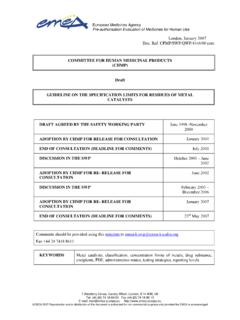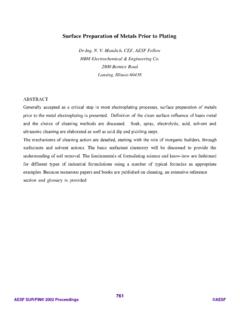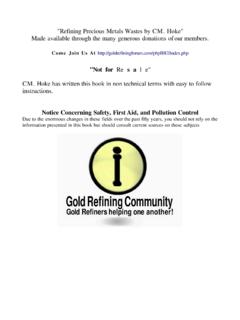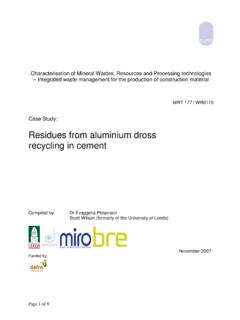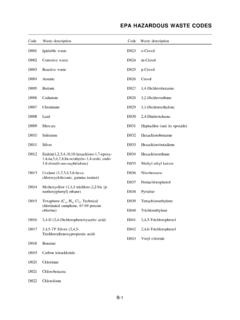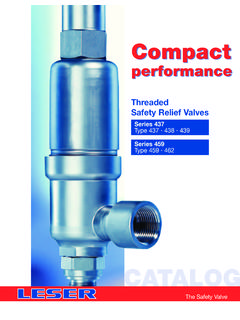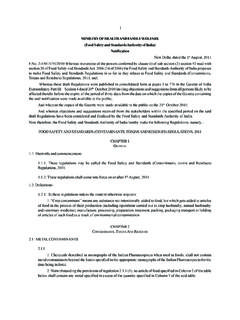Transcription of Guideline on the Specification Limits for Residues …
1 European Medicines Agency London, 21 February 2008. Doc. Ref. EMEA/CHMP/SWP/4446/2000. COMMITTEE FOR MEDICINAL PRODUCTS FOR HUMAN USE. (CHMP). Guideline ON THE Specification Limits FOR Residues OF metal . CATALYSTS OR metal REAGENTS. DRAFT AGREED BY THE SAFETY WORKING PARTY June 1998 -November 2000. ADOPTION BY CHMP FOR RELEASE FOR CONSULTATION January 2001. END OF CONSULTATION (DEADLINE FOR COMMENTS) July 2001. DISCUSSION IN THE SWP October 2001 June 2002. ADOPTION BY CHMP FOR RE- RELEASE FOR June 2002. CONSULTATION. DISCUSSION IN THE SWP February 2003 . December 2006. ADOPTION BY CHMP FOR RE- RELEASE FOR January 2007. CONSULTATION. END OF CONSULTATION (DEADLINE FOR COMMENTS) 23rd May 2007. DRAFT AGREED BY THE SAFETY WORKING PARTY December 2007. ADOPTION BY CHMP 21 February 2008. DATE FOR COMING INTO EFFECT 01 September 2008. KEYWORDS metal catalysts, classification, concentration Limits of metals, drug substance, excipients, PDE, administration routes, testing strategies, reporting levels 7 Westferry Circus, Canary Wharf, London, E14 4HB, UK.
2 Tel. (44-20) 74 18 84 00 Fax (44-20) 74 18 86 13. E-mail: European Medicines Agency, 2008. Reproduction is authorised provided the source is acknowledged. Guideline ON THE Specification Limits FOR Residues OF metal . CATALYSTS OR metal REAGENTS. TABLE OF CONTENTS. EXECUTIVE 3. 1. INTRODUCTION (BACKGROUND) .. 3. 2. DEFINITION AND 4. 3. LEGAL BASIS .. 4. 4. MAIN Guideline TEXT .. 5. CLASSIFICATION .. 5. EXPOSURE Limits .. 5. SETTING CONCENTRATION Limits metal Residues .. 6. 6. Pharmaceutical products applied via the oral, parenteral or inhalation route of administration.. 6. Pharmaceutical products applied via other routes of 7. Pharmaceutical products used for short-term and for life-saving 7. ANALYTICAL PROCEDURES .. 7. BATCH RESULTS, TESTING FREQUENCY AND DELETING OF A TEST FROM THE. Specification .. 8. REPORTING LEVELS OF METALLIC Residues .. 8. 5. GLOSSARY .. 9. 6. REFERENCES (SCIENTIFIC AND / OR LEGAL) .. 11. APPENDIX 1: RATIONALE FOR PDE 12.
3 APPENDIX 2: MONOGRAPHS ON ELEMENTS .. 14. PLATINUM (PT) .. 14. PALLADIUM (PD) .. 16. IRIDIUM (IR).. 18. RHODIUM (RH) .. 18. RUTHENIUM (RU) .. 19. OSMIUM (OS) .. 20. MOLYBDENUM (MO) .. 20. NICKEL (NI).. 22. CHROMIUM (CR) .. 23. VANADIUM (V) .. 26. COPPER (CU) .. 27. MANGANESE (MN) .. 28. ZINC (ZN) .. 30. IRON (FE) .. 31. APPENDIX 3: EXAMPLE CALCULATIONS FOR CONCENTRATION Limits .. 33. Page 2/34. EXECUTIVE SUMMARY. The objective of this Guideline is to recommend maximum acceptable concentration Limits for the Residues of metal catalysts or metal reagents that may be present in pharmaceutical substances or in drug products. A pharmaceutical substance is defined here as a substance that is either an active pharmaceutical ingredient or an excipient. The metals addressed in this Guideline are normally used as process catalysts or reagents during the synthesis of pharmaceutical substances. Their use may lead to Residues in the final pharmaceutical substance, and consequently in the final drug product.
4 Such metal Residues do not provide any therapeutic benefit to the patient and should therefore be evaluated and restricted on the foundation of safety- and quality-based criteria. The Guideline may be updated to include other metal Residues in due course. This Guideline classifies metal Residues into three categories based on their individual level of safety concern and sets concentration Limits . The Limits are based on the maximal daily dose, duration of treatment, and administration route of the drug product as well as the permitted daily exposure (PDE). of the metal residue. The Guideline also includes recommendations on testing strategies, analytical procedures and reporting levels in pharmaceutical substances or drug products. 1. INTRODUCTION. metal Residues in pharmaceutical substances or drug products may originate from several sources like metal catalysts and metal reagents used during the synthesis of the active pharmaceutical substance and the excipients, manufacturing equipment and piping, bulk packaging, the environment, cleaning solvents etc.
5 Since metal Residues do not provide any therapeutic benefit to the patient, and product risk should commensurate with the level of product benefit, the Specification of a pharmaceutical substance or the drug product may need to include a limit and validated method for metal Residues to guarantee acceptable product quality. The considerations for such a requirement should be made in a manner that is consistent with safety- and quality-based criteria as well as GMP, GDP and any other relevant provisions. The objective of this Guideline is to recommend maximum acceptable concentration Limits of metal Residues arising from the use of metal catalysts or metal reagents in the synthesis of drug substances and excipients. Since the use of these metals is restricted to defined chemical reactions, limitation of their Residues in pharmaceutical substances themselves will normally be sufficient. Thus, limitation of these metal Residues in the final drug product will normally not be necessary.
6 The concentration Limits in this Guideline are based on safety criteria and assure an adequate quality of the pharmaceutical substance and the drug product. It is therefore not considered appropriate to expect that the pharmaceutical industry tightens the concentration Limits in the regulatory dossier on basis of GMP, process capabilities, or any other quality criteria. Since the origin of metal Residues is irrelevant regarding their potential toxic effects, the concentration Limits in this Guideline are in principle also applicable to Residues from other sources than catalysts and reagents. However, for these other sources adoption of a concentration limit and a validated method in the Specification is only necessary in the very exceptional cases where these Residues are known to be insufficiently limited by GMP, GDP or any other relevant provision. Pharmaceutical companies are not supposed to perform extensive tests on metal residue findings of unknown sources to comply with this Guideline .
7 They may rely on general information from trustworthy suppliers. The metals that are currently included in this Guideline are listed in Table 1. The Guideline may be updated to include other metal Residues in due course. Any interested party can make a request and submit the relevant safety data. The classification and concentration Limits of the currently included metals may also change when new safety data becomes available. Page 3/34. The following assumptions and/or default values have been used during establishment of the concentration Limits : Body weight (bw) of an adult: 50 kg. Breathing volume of an adult: 20 m3 per day (24 h). Occupational (workplace) inhalation exposure: 8 h per day (24 h). Exposure Limits were established using uncertainty factors as described in appendix 3 of the ICH Q3C guidance. For pragmatic reasons a number of uncertainty factors were adapted to arrive at a final safe and practical PDE setting - Q3C method for uncertainty factor (UF) calculation plus additional pragmatic factor for PDE calculation.
8 Acceptable additional lifetime cancer risk: an increased cancer risk of 1 in 100,000 was identified as acceptable for genotoxic impurities in pharmaceuticals by the CHMP. 2. DEFINITION AND SCOPE. metal catalysts and metal reagents are defined here as chemical substances that are used to change the rate of chemical reactions or which act on other chemical substances in chemical reactions. For the purpose of this Guideline , metal catalysts and metal reagents refer to metals used in the synthesis of the active pharmaceutical ingredient, the synthesis of any of the pharmaceutical excipients, or the synthesis of any of the pharmaceutical excipients used during the manufacture of the drug product but no longer present in the drug product itself. metal Residues can either be present in the original form of the metal or as a form of the metallic element altered by downstream chemical processing. This Guideline applies to new and existing marketed drug products.
9 However, for existing marketed drug products a time limit of 5 years is set for the implementation of the Guideline in case an earlier implementation is not feasible. Following this 5 years implementation, transitional period only drug products which have been manufactured using pharmaceutical substances which comply with the Guideline can be released to the market. This Guideline does not apply to potential new drug substances or to excipients used during the clinical research stages of development of a medicinal product. During the clinical research stages of development, higher Limits of metal Residues might be acceptable. The Guideline does also not apply to metals that are deliberate components of the pharmaceutical substance (such as a counter ion of a salt) or metals that are used as a pharmaceutical excipient in the drug product ( an iron oxide pigment). As described in the introduction, the Guideline does normally not apply to extraneous metal contaminants that are more appropriately addressed by GMP, GDP or any other relevant quality provision.
10 The route of administration may influence the actual exposure of the human body to the metal . Due to the limited oral bioavailability of many metals, this Guideline applies different Limits to oral and parenteral routes of administration. As other routes of exposure may have different toxicological implications, specific Limits have also been set for the inhalation exposure to some metals. When the exposure is short, the PDEs mentioned in this Guideline may be adapted as indicated in section 3. LEGAL BASIS. This Guideline should be read in conjunction with Directive 2001/83/EC as amended and in conjunction with all relevant CHMP guidance documents, with special emphasis on: Note for Guidance on Impurities in New Drug Products (CPMP/ICH/2738/99, ICHQ3B (R)). Impurities Testing Guideline : Impurities in New Drug Substances (CPMP/ICH/2737/99, ICHQ3A). Note for Guidance on Impurities: Residual Solvents (CPMP/ICH/283/95 in conjunction with CPMP/ICH/1507/02, CPMP/ICH/1940/00 corr, CPMP/QWP/450/03 and CPMP/QWP/8567/99).










